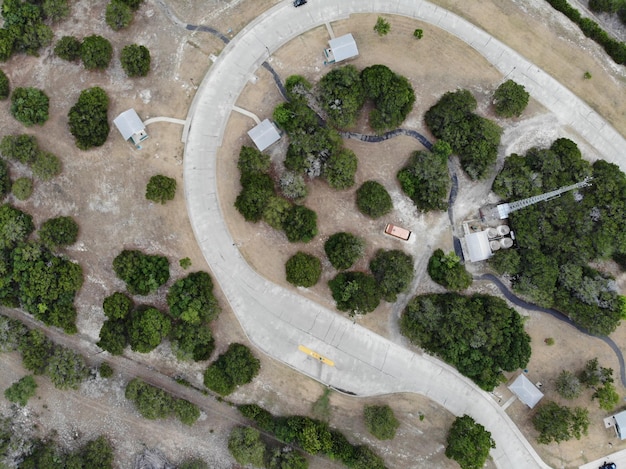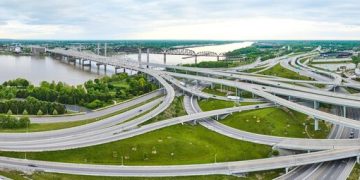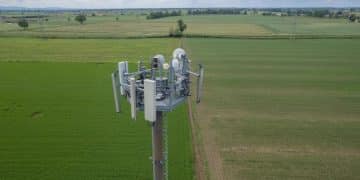US Infrastructure Bill: Key Provisions & Timeline Explored

The newly passed Infrastructure Investment and Jobs Act allocates substantial federal funding towards modernizing America’s foundational infrastructure, encompassing a wide array of projects from transportation and broadband to clean energy, with phased timelines spanning the next five to ten years.
The passage of a significant infrastructure bill marks a pivotal moment for the United States, promising to reshape the nation’s physical and digital landscapes. Understanding what are the key provisions of the newly passed infrastructure bill and their projected timeline is crucial for citizens, businesses, and policymakers alike, as it delineates the scope of investments and the anticipated pace of their implementation across various critical sectors.
Setting the Stage: The Infrastructure Investment and Jobs Act (IIJA)
The Infrastructure Investment and Jobs Act (IIJA), often simply referred to as the Bipartisan Infrastructure Law, represents a landmark piece of legislation. It signifies the largest long-term investment in American infrastructure in generations, aiming to modernize crumbling roads, bridges, and transit systems while also expanding access to clean drinking water, high-speed internet, and a nation-wide network of electric vehicle charging stations. This bill is not merely about repair; it is about building for the future, fostering economic growth, and enhancing the quality of life for millions of Americans.
Historical Context and Legislative Journey
The idea of a substantial infrastructure package has been a recurring theme in Washington for decades, with bipartisan calls to address the nation’s aging systems. However, achieving consensus on the scale and funding mechanisms proved challenging. The IIJA’s journey through Congress was complex, involving extensive negotiations between Democrats and Republicans. Its passage in November 2021 was celebrated as a rare instance of bipartisan cooperation on a major domestic issue, demonstrating a shared understanding of the urgent need to invest in foundational public works.
- Bipartisan Negotiations: The bill was the result of months of talks between the Biden administration and a bipartisan group of senators.
- Congressional Passage: It passed the Senate in August 2021 and the House of Representatives in November 2021, moving through both chambers with significant support from both parties.
- Presidential Signature: President Biden signed the bill into law on November 15, 2021, initiating the process of its implementation.
The law allocates approximately $1.2 trillion over ten years, with about $550 billion representing new federal investments over existing planned spending. This substantial injection of funds is designed to be transformative, addressing deficiencies that have accumulated over many years due to underinvestment. The legislation’s scope touches nearly every aspect of daily life, from how goods are transported to how communities are connected, highlighting its broad and pervasive impact.
Understanding the fundamental motivations behind the IIJA is key to appreciating its provisions. The objective was not just to fix immediate problems but to create a more resilient, equitable, and sustainable infrastructure system. This forward-looking approach is evident in the bill’s emphasis on clean energy, climate resilience, and broadband expansion, setting the stage for future economic competitiveness and national well-being. The initial stages of implementation involved establishing new programs and updating existing ones to effectively channel funds to states and localities.
Transforming Transportation: Roads, Bridges, and Public Transit
A cornerstone of the Infrastructure Investment and Jobs Act is its ambitious commitment to revitalizing America’s transportation networks. Decades of deferred maintenance have left countless roads and bridges in disrepair, leading to increased commute times, higher vehicle maintenance costs, and compromised safety. The IIJA seeks to reverse this trend by allocating significant funds to repair, rebuild, and modernize these critical arteries of commerce and daily life.
Road and Bridge Revitalization
The bill dedicates a staggering $110 billion specifically for roads and bridges, marking the largest federal investment in these areas in half a century. A substantial portion of these funds is earmarked for existing programs designed to repair and replace structurally deficient bridges and rehabilitate aging highways. This includes funding for the Bridge Formula Program, which provides dedicated resources to states to fix and replace bridges. The immediate impact will be felt in reduced traffic congestion and enhanced safety across the nation’s road system, enabling more efficient movement of goods and people.
- Bridge Formula Program: An $27.5 billion allocation specifically for bridge repair and replacement.
- Highway Programs: Over $40 billion for repair and modernization of federal-aid highways, including projects focused on safety and climate resilience.
- Major Projects: Funding for transformative projects that cross state lines or are extraordinarily expensive, addressing critical bottlenecks.
States are already in the process of identifying eligible projects and submitting proposals to the federal government. The initial phase focused on urgent repairs and shovel-ready projects that could quickly put people to work. Over the next five years, these investments are projected to facilitate substantial improvements in road conditions, reduce the backlog of bridge repairs, and enhance the overall efficiency of the transportation network. The long-term timeline extends beyond five years for the full impact of these sustained investments to be realized, particularly for larger, more complex undertakings. This sustained investment approach ensures that solutions are durable and comprehensive, avoiding short-term fixes that may lead to future problems.
Investing in Public Transit and Rail
Beyond roads and bridges, the IIJA also makes significant investments in public transportation and passenger rail, recognizing their vital role in urban mobility and environmental sustainability. Approximately $39 billion is allocated to public transit specifically to modernize fleets, expand routes, and improve accessibility. This includes replacing thousands of aging transit vehicles with zero-emission models, improving efficiency, and ensuring that public transportation serves diverse communities effectively. The projected timeline for these transit improvements varies, with some projects seeing rapid implementation while larger system upgrades may take several years to complete.
The bill also provides $66 billion for Amtrak and rail systems. This funding aims to address Amtrak’s maintenance backlog, improve service along congested corridors, and expand high-speed rail lines. The ambition is to create a more integrated and efficient national rail network, offering a viable alternative to air and car travel for intercity journeys. These rail projects often have longer lead times due to their complexity, requiring extensive planning, environmental reviews, and construction phases. While some improvements may be visible within the next 2-3 years, major expansion projects could stretch over the next decade. The collective impact on transportation infrastructure is expected to be transformative, leading to safer, more efficient, and more sustainable modes of travel for millions of Americans.
These transportation provisions are designed not only to alleviate current problems but also to prepare the nation for future population growth and evolving transportation needs. By investing in a diversified portfolio of transit options, the bill aims to improve connectivity, reduce carbon emissions, and foster a more accessible transportation ecosystem for all. Both urban and rural areas are set to benefit, addressing long-standing disparities in infrastructure development. The emphasis on safety, particularly in road and bridge construction, underpins all these investments, aiming to reduce accidents and enhance overall travel security. The process of awarding grants and funds involves careful oversight to ensure accountability and effective deployment of resources.
Modernizing Utilities: Water, Broadband, and Power Grids
Beyond traditional transportation, the Infrastructure Investment and Jobs Act makes crucial investments in modernizing America’s utility infrastructure. These provisions address fundamental needs: access to clean water, reliable high-speed internet, and resilient power grids. Each of these components is essential for public health, economic development, and daily life in the 21st century, and the bill allocates significant resources to bring these systems up to modern standards.
Ensuring Clean Drinking Water
The bill dedicates $55 billion to upgrading America’s water infrastructure. A significant portion of this funding, $15 billion, is specifically targeted at replacing lead service lines, a critical public health issue that impacts communities across the country. Lead contamination in drinking water poses serious health risks, particularly to children. This investment aims to eliminate all lead pipes, ensuring safer drinking water for millions. Another $10 billion is allocated to address PFAS (per- and polyfluoroalkyl substances) contamination, also known as “forever chemicals,” which are a growing environmental and health concern. The remaining funds support other essential water infrastructure projects, including wastewater treatment and stormwater management.
- Lead Pipe Replacement: $15 billion specifically for removing and replacing lead service lines.
- PFAS Remediation: $10 billion to address toxic “forever chemicals” in drinking water.
- Other Water Projects: Billions for water infrastructure resilience, clean water state revolving funds, and Western water infrastructure.
The projected timeline for these water projects spans the next five to ten years. Replacing lead lines is a labor-intensive process that requires significant coordination with local communities. While some impacted areas will see rapid improvements, a comprehensive national overhaul will take time. Similarly, addressing PFAS contamination involves complex remediation strategies. The initial phase focused on identifying high-priority areas and establishing frameworks for funding distribution, with actual construction and remediation efforts now underway or in the planning stages for continuous implementation over the coming years. This long-term commitment reflects the deep-seated nature of these water quality challenges.

Expanding High-Speed Internet Access
Recognizing broadband internet as a necessity rather than a luxury, the IIJA allocates $65 billion to expand high-speed internet access across the nation. This investment is crucial for closing the digital divide, particularly in rural and low-income areas where access is limited or nonexistent. The funding aims to ensure that every American has access to affordable, reliable high-speed internet, supporting education, remote work, telemedicine, and economic opportunity. A significant portion targets infrastructure deployment, while other funds are dedicated to affordability and digital equity programs.
The timeline for achieving universal broadband access is ambitious. The bill provides funds over a five-year period, with the goal of connecting every American by the end of the decade. States are currently developing plans and identifying unserved and underserved areas. The initial phase involved setting up state broadband offices and securing grant applications. Construction of new fiber optic networks and other broadband infrastructure will largely occur over the next 3-7 years. This is a complex undertaking, involving trenching, cable laying, and connection to individual homes, but its completion promises to unlock substantial economic and social benefits, bridging gaps that have widened in the digital age.
Strengthening the Electric Grid and Clean Energy
A resilient and modern electric grid is fundamental to national security and economic stability. The IIJA invests $73 billion in power infrastructure, focusing on upgrading the nation’s electric grid, expanding renewable energy, and promoting energy efficiency. This includes funding for smart grid technologies, which can better manage energy flow and improve reliability, as well as investments in clean energy transmission projects. The goal is to make the grid more resilient to extreme weather events, cybersecurity threats, and the demands of an evolving energy landscape.
Furthermore, the bill includes provisions for demonstrating and deploying advanced clean energy technologies, such as carbon capture, hydrogen energy, and advanced nuclear reactors, aligning with the nation’s climate goals. The deployment of electric vehicle charging infrastructure also falls under this umbrella, with $7.5 billion dedicated to building a national network of 500,000 EV chargers. The timeline for these energy and grid projects varies significantly. Some grid upgrades can be implemented relatively quickly, while major transmission lines or new clean energy projects have timelines stretching five to ten years or more, factoring in regulatory approvals, land acquisition, and construction. This comprehensive approach to utilities lays the groundwork for a more robust, sustainable, and equitable future for all Americans, critical for adapting to a changing climate and transitioning to a cleaner economy.
Climate Resilience and Environmental Remediation
The Infrastructure Investment and Jobs Act is not solely focused on traditional infrastructure; it also addresses critical issues related to climate change resilience and environmental remediation. Recognizing the increasing frequency and intensity of extreme weather events, the bill incorporates significant investments aimed at protecting communities and ecosystems. These provisions are forward-looking, seeking to mitigate future damages and restore areas affected by past industrial activities, demonstrating a holistic approach to infrastructure development that prioritizes long-term sustainability and public safety.
Building Resilience Against Extreme Weather
With an estimated $50 billion allocated for climate resilience, the IIJA represents a substantial commitment to preparing communities for the impacts of climate change. This funding goes towards a variety of initiatives, including coastal restoration projects, enhanced flood protection measures, wildfire prevention and mitigation efforts, and drought resilience programs in Western states. Investments are designed to protect critical infrastructure from the effects of severe weather, such as stronger storms, rising sea levels, and prolonged droughts. This includes modernizing infrastructure to withstand these impacts and restoring natural defenses like wetlands and barrier islands.
The timeline for these resilience projects is ongoing and adaptive. Many projects involve long-term planning and continuous implementation as climate patterns evolve. Initial efforts focus on areas highly vulnerable to specific climate hazards, with grants being rolled out to state and local governments. While some immediate protective measures can be taken, the full benefits of a resilient infrastructure network will accumulate over the next decade as comprehensive strategies are put into place. This is an adaptive process, with investments guided by evolving climate science and regional vulnerabilities, ensuring that funding is directed where it can have the most significant protective effect.

Cleaning Up Legacy Pollution and Brownfields
The bill also addresses the legacy of industrial pollution, with significant investments in environmental remediation. Over $20 billion is designated for cleaning up brownfield and superfund sites, abandoned mines, and capping orphaned oil and gas wells. These sites pose significant environmental hazards and often blight communities, impeding economic redevelopment. The clean-up efforts aim to remove contaminants, restore land, and facilitate the safe reuse of these properties, contributing to healthier environments and creating new opportunities for development.
Specifically, the IIJA provides $21 billion for environmental remediation efforts. This includes $3.5 billion for the Superfund program, allowing for the cleanup of hundreds of contaminated sites. Another $11.3 billion is allocated to cleaning up orphaned oil and gas wells and abandoned mines, addressing immediate safety and environmental risks while creating jobs in affected communities. The projected timeline for these clean-up projects varies depending on the complexity and scale of contamination. Orphaned well capping can begin almost immediately, with many projects completed within a few years. Superfund and brownfield clean-ups, however, can be multi-year undertakings, often requiring extensive site assessments, regulatory approvals, and specialized remediation techniques, ensuring a thorough and safe restoration of these lands for future use. The goal is to systematically address the most pressing environmental hazards, reducing exposure to pollutants and unlocking economic potential in previously blighted areas, particularly benefiting vulnerable communities that often bear the brunt of historical industrial pollution.
These investments in environmental remediation are critical for improving public health and fostering economic revitalization in affected communities. By removing contamination and making previously unusable land safe, the bill creates opportunities for new businesses, housing, and recreational spaces. The long-term impact extends to enhanced ecological health and an improved quality of life for residents living near these sites. The provisions also support jobs in environmental services and construction, contributing to local economies. This dual focus on resilience and remediation underscores the comprehensive ambition of the IIJA to build a safer, cleaner, and more sustainable future for the nation.
Jobs, Equity, and Economic Impact
Beyond the concrete and steel, the Infrastructure Investment and Jobs Act is fundamentally designed to be a catalyst for economic growth and job creation, while also addressing issues of equity and workforce development. The billions of dollars infused into infrastructure projects are projected to generate a significant number of well-paying jobs, directly and indirectly, and contribute to long-term economic competitiveness. The bill also emphasizes equitable access to infrastructure benefits, aiming to rectify historical disparities in investment.
Job Creation Projections
Economists and policymakers anticipate that the IIJA will create millions of jobs across various sectors. Direct jobs will arise in construction, engineering, manufacturing, and skilled trades as projects get underway. Indirect jobs will be generated throughout the supply chain, from raw material suppliers to transportation services. Furthermore, induced jobs will result from increased consumer spending by workers earning wages from these projects. The White House Council of Economic Advisers estimated that the bill would add, on average, 1.5 million jobs per year over the next decade, with a focus on manufacturing and construction sectors previously affected by economic downturns.
- Direct Employment: Jobs in construction, engineering, and manufacturing.
- Indirect Employment: Roles in supply chains, logistics, and related support services.
- Induced Employment: Jobs created by increased economic activity and consumer spending.
The projected timeline for job creation is immediate and sustained. Initial job growth occurred as early projects began, with sustained employment opportunities anticipated as more complex and long-term projects ramp up over the next five to ten years. The emphasis is on good-paying union jobs, supporting a strong middle class. This employment surge is expected to boost local economies, particularly in areas where infrastructure improvements are most needed, contributing to a more robust national economy and improving financial security for many families.
Advancing Equity and Workforce Development
A key aspect of the IIJA is its focus on equity. The bill includes provisions to ensure that historically underserved communities receive their fair share of infrastructure investments, addressing past injustices and promoting equitable access to essential services. This includes targeting funds to improve infrastructure in tribal communities, low-income neighborhoods, and rural areas that have often been neglected. For instance, the broadband provisions specifically aim to close the digital divide that disproportionately affects these communities.
The legislation also places a strong emphasis on workforce development, ensuring that there is a skilled labor force available to undertake these complex projects. This includes funding for job training programs, apprenticeships, and initiatives aimed at recruiting diverse talent into the infrastructure workforce. The goal is to build a modern workforce capable of designing, building, and maintaining 21st-century infrastructure. The timeline for these equity and workforce initiatives is ongoing. While some programs can be launched quickly, building a truly diverse and skilled workforce and ensuring equitable distribution of funds will be a continuous effort over the next decade, fostering sustainable growth and opportunity across all demographics.
These integrated approaches to job creation, equity, and workforce development underscore the holistic ambition of the IIJA. It is not just about physical structures but also about strengthening communities and fostering economic inclusion. By investing in people as well as projects, the bill aims to create a durable foundation for future prosperity, ensuring that the benefits of modernized infrastructure are widely shared. The implementation includes federal agencies working closely with states and localities to identify areas of greatest need and to develop programs that provide equitable access to opportunities, ensuring that the investment translates into tangible improvements for all Americans.
Challenges and Oversight in Implementation
While the Infrastructure Investment and Jobs Act represents a historic investment, its successful implementation is not without challenges. The sheer scale of the funding, the complexity of the projects, and the need for coordinated action across multiple levels of government require robust oversight, strategic planning, and adaptive management. Ensuring that funds are spent efficiently, transparently, and effectively is paramount to realizing the bill’s ambitious goals and justifying taxpayer investment.
Navigating Implementation Hurdles
One primary challenge is ensuring that states and local governments have the capacity to absorb and effectively utilize such a significant influx of federal funds. Many smaller communities may lack the engineering expertise, project management capabilities, or administrative staff to quickly ramp up new projects. Supply chain disruptions and inflation also pose potential hurdles, impacting the cost and timeline of construction materials and labor. Furthermore, navigating complex permitting processes, especially for larger projects involving environmental reviews and right-of-way acquisitions, can cause delays. Federal agencies are working to streamline these processes and provide technical assistance to states to expedite project readiness.
Another significant hurdle involves the coordination among various federal agencies, state departments of transportation, local authorities, and private contractors. This necessitates a “whole-of-government” approach to ensure seamless execution and avoid duplication of efforts or conflicting priorities. The Biden administration established an Infrastructure Implementation Coordinator to oversee and manage this complex interagency effort, indicating the level of attention dedicated to smooth execution. Lessons learned from previous large-scale federal infrastructure programs are being incorporated to mitigate potential bottlenecks and ensure a more agile and responsive implementation process.
Ensuring Transparency and Accountability
Given the unprecedented investment, robust oversight mechanisms are critical to prevent waste, fraud, and abuse. The IIJA includes provisions for transparency and accountability reporting, requiring agencies to track spending and project progress. Various federal watchdogs, including the Government Accountability Office (GAO) and Inspectors General, will play key roles in monitoring how funds are allocated and utilized. The public also has a role to play, with many agencies providing online dashboards and resources to track specific projects in their communities. This multi-layered approach to oversight is designed to instill public confidence and ensure that every dollar is spent judiciously.
The projected timeline for this oversight and accountability is continuous throughout the lifespan of the bill. It began immediately upon passage and will continue for the duration of the ten-year investment period, with regular audits and performance reviews. This ongoing scrutiny is essential to identifying problems early, implementing corrective actions, and ensuring that the investments deliver their promised benefits to the American people. The emphasis is on data-driven decision-making and public reporting, fostering a culture of transparency that strengthens overall program integrity. The success of the IIJA will ultimately hinge on the diligent and effective management of its wide-ranging provisions, turning ambitious legislative goals into tangible improvements across the nation.
| Key Provision | Brief Description |
|---|---|
| 🛣️ Roads & Bridges | Largest federal investment in decades for repairing and modernizing the nation’s transportation networks. |
| 💧 Clean Water & Broadband | Significant funding for lead pipe replacement, PFAS remediation, and universal high-speed internet access. |
| ⚡ Power Grid & Climate Resilience | Upgrades to the electric grid, clean energy infrastructure, and measures to protect against extreme weather events. |
| 👥 Jobs & Equity | Projected creation of millions of jobs, with a focus on equitable distribution of benefits and workforce development programs. |
Frequently Asked Questions About the Infrastructure Bill
▼
The IIJA includes approximately $1.2 trillion over ten years, with about $550 billion in new federal investments specifically for infrastructure improvements. This significant funding is designed to modernize various sectors across the United States, representing a substantial commitment to public works.
▼
The bill allocates significant funds for climate resilience, including $50 billion for protecting infrastructure from extreme weather, and investments in a modernized electric grid for renewable energy and electric vehicle charging infrastructure, aiming to reduce carbon emissions and build a more sustainable future.
▼
The timeline varies by project type. Many smaller repairs and upgrades will see relatively quick implementation over the next 2-5 years. Larger, more complex projects like major bridge replacements, new rail lines, or comprehensive environmental clean-ups may stretch over 5-10 years, or even longer for full completion.
▼
The IIJA is projected to create millions of jobs. Direct jobs will be in construction and engineering; indirect jobs in supply chains; and induced jobs through increased spending. The focus is on employing a diverse workforce in good-paying union jobs across the country, boosting local and national economies.
▼
Funds are distributed to states and local governments through existing and new grant programs. Oversight involves continuous monitoring by federal agencies, Inspectors General, and the GAO, alongside public transparency dashboards, to ensure efficient and accountable spending of taxpayer dollars and project integrity.
Conclusion
The Infrastructure Investment and Jobs Act is a monumental initiative poised to redefine America’s foundational systems for decades to come. By addressing critical needs in transportation, utilities, climate resilience, and environmental remediation, the bill lays the groundwork for a more robust, sustainable, and equitable future. While the scale of the undertaking presents inherent challenges in implementation and oversight, the commitment to modernizing the nation’s infrastructure promises not only direct economic benefits through job creation but also a long-term enhancement in the quality of life, economic competitiveness, and environmental health across the United States. Its success will ultimately depend on sustained cooperation and diligent execution, setting a precedent for future strategic investments in the nation’s core assets.





